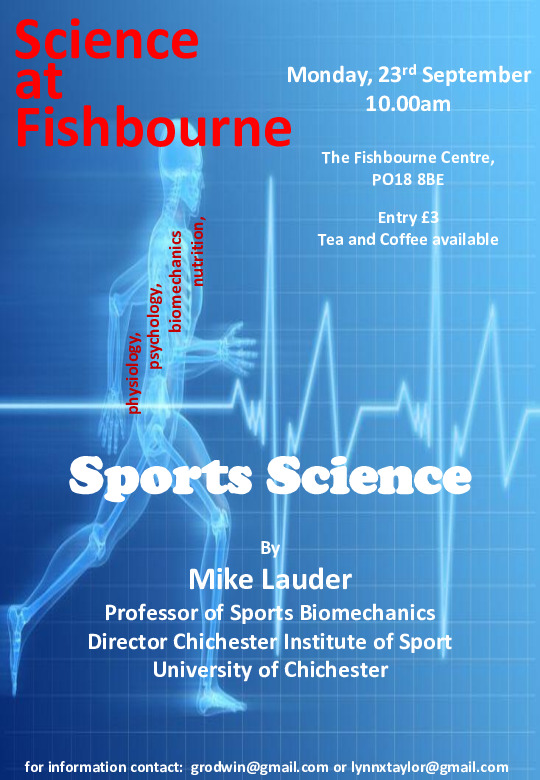
Lynn’s Review
Those of us who only know sport at school and college as: physical education, came away from today’s science talk with plenty of new information to process. If we hadn’t thought of science connections to P.E before, then knowing that science is: the systematic study of the physical and natural world through observation and experimentation, should put us straight.
The Sports Science department at Chichester University has surely emerged, as innovations in technology have progressed. I was particularly interested to see that although individual aspects of physical movement are analysed, as perhaps an engineer would look at working parts, areas such as nutrition and mental well-being are also researched, so leading to a more holistic approach when observing and prescribing for the human as a whole.
Mike Lauder, is Director of the Chichester Institute of Sport, Nursing and Allied Health, Professor of Sports Biomechanics & Cross-Institutional Lead for Health and Sam Blacker is Professor of Exercise Physiology and Nutrition and co-leads the Occupational Performance Research Group. Together, they gave a broad picture of the multi-disciplinary approach to Sports Science at Chichester University. Areas covered include: strength and conditioning; aerobic exercise; sociology; coaching; teams; psychology; physiology. Courses look at the questions: how do bodies work? And how to make it better. There are courses for those who want to dive into the detail of biomechanics and also for surfing such connected areas as medicine and engineering.
Sports Science research groups at the university focus on: “Issues and strategies related to developing and maintaining wellbeing, performing well in challenging environments, and discovering more about who we are in the process. We also work on a range of urgent issues related to representation and equality in sport.” (https://www.chi.ac.uk/research/centres/centre-for-health-and-allied-sport-and-exercise-science-research-chaser/)
Current groups relate to: teaching children; diversity and equality; enhancing sport performance; health and wellbeing; nutritional supplementation; occupational performance and integrated caring science research.
One of the elite sports performers: Cristiano Ronaldo, helped with the department’s research when they recently used instruments with markers to track what makes him one of the best football players in the world. Instruments were used to assess his sprinting, free kick taking and his ability to jump high.
A range of devices can be used to measure: oxygen used, calories needed; heart rate; deep core body temperature; fluid intake; movements made.
Forces that influence movement are also studied to improve performance, or to reduce risk of injury.
Speedo developed a low friction swimsuit, tested in wind tunnels used for rockets, by NASA. It proved so effective at reducing the forces acting against the swimmer, related to skin friction and drag, that it has been banned from use in competitions: by 2009, 93 world records had been beaten by swimmers wearing the suit.
Double labelled water, is another tool that has been used when working with the Infantry, helping to measure the impact of exercise under stress conditions:
“The method involves enriching the body water of a subject with heavy hydrogen (2H) and heavy oxygen (18O), and then determining the difference in washout kinetics between both isotopes, being a function of carbon dioxide production. In practice, subjects get a measured amount of doubly labelled water (2H218O) to increase background enrichment of body water for 18O of 2000 ppm with at least 180 ppm and background enrichment of body water for 2H of 150 ppm with 120 ppm. Subsequently, the difference between the apparent turnover rates of the hydrogen and oxygen of body water is assessed from blood-, saliva-, or urine samples, collected at the start and end of the observation interval of 1–3 weeks.” (https://www.ncbi.nlm.nih.gov/pmc/articles/PMC5486561/)
I discovered this link about the use of double labelled water, which I also found interesting:
“Although generally now accepted, one of the major surprises from the early applications of DLW was that obese individuals have higher energy expenditures than lean controls. Moreover, weight gain, even in the already obese, is associated with an increase in energy expenditure as weight is one of the strongest predictors of total energy expenditure.” (https://www.nature.com/articles/ijo2008241)
An accelerometer in the form of a watch, is used to measure energy expenditure and an assessment of body size, calorie intake and activity can be made. This helps to determine the correct nutrition to maintain an athletic body composition, for example: in boxers and gymnasts. This is an important tool, as incorrect balance has a negative impact, and can lead to infertility in females, bone loss and other negative health consequences.
I was truly impressed by the range of subjects now covered by Sports Science at Chichester University, and of the benefits to health. Interested people can also engage in their projects or attend their open events: (https://www.chi.ac.uk/about-us/events/)
I hope that I have captured most of the information given by Mike and Sam. I’ve just eaten some polyphenols to improve the speed and duration of my dog walk and I’m off now before it rains again.